Introduction to People Management: Leadership, Training, Talent Management at Nissan
VerifiedAdded on 2023/06/15
|9
|2462
|229
AI Summary
This report covers leadership, training, and talent management at Nissan in the context of people management. It discusses different leadership styles, the importance of training and development, and talent management strategies. It also recommends the knowledge, skills, and behavior required for effective management.
Contribute Materials
Your contribution can guide someone’s learning journey. Share your
documents today.

Introduction to People
Management
Management
Secure Best Marks with AI Grader
Need help grading? Try our AI Grader for instant feedback on your assignments.
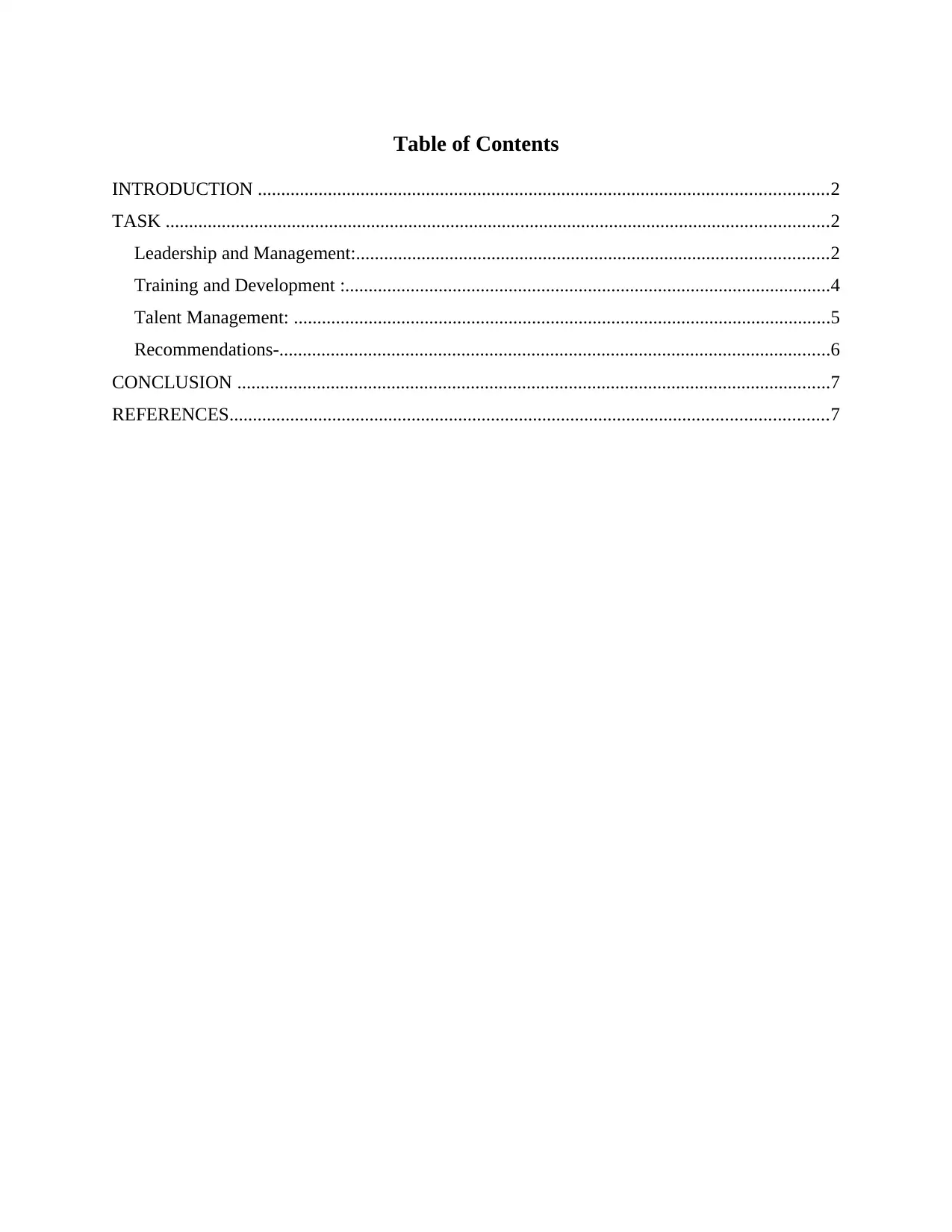
Table of Contents
INTRODUCTION ..........................................................................................................................2
TASK ..............................................................................................................................................2
Leadership and Management:.....................................................................................................2
Training and Development :........................................................................................................4
Talent Management: ...................................................................................................................5
Recommendations-......................................................................................................................6
CONCLUSION ...............................................................................................................................7
REFERENCES................................................................................................................................7
INTRODUCTION ..........................................................................................................................2
TASK ..............................................................................................................................................2
Leadership and Management:.....................................................................................................2
Training and Development :........................................................................................................4
Talent Management: ...................................................................................................................5
Recommendations-......................................................................................................................6
CONCLUSION ...............................................................................................................................7
REFERENCES................................................................................................................................7
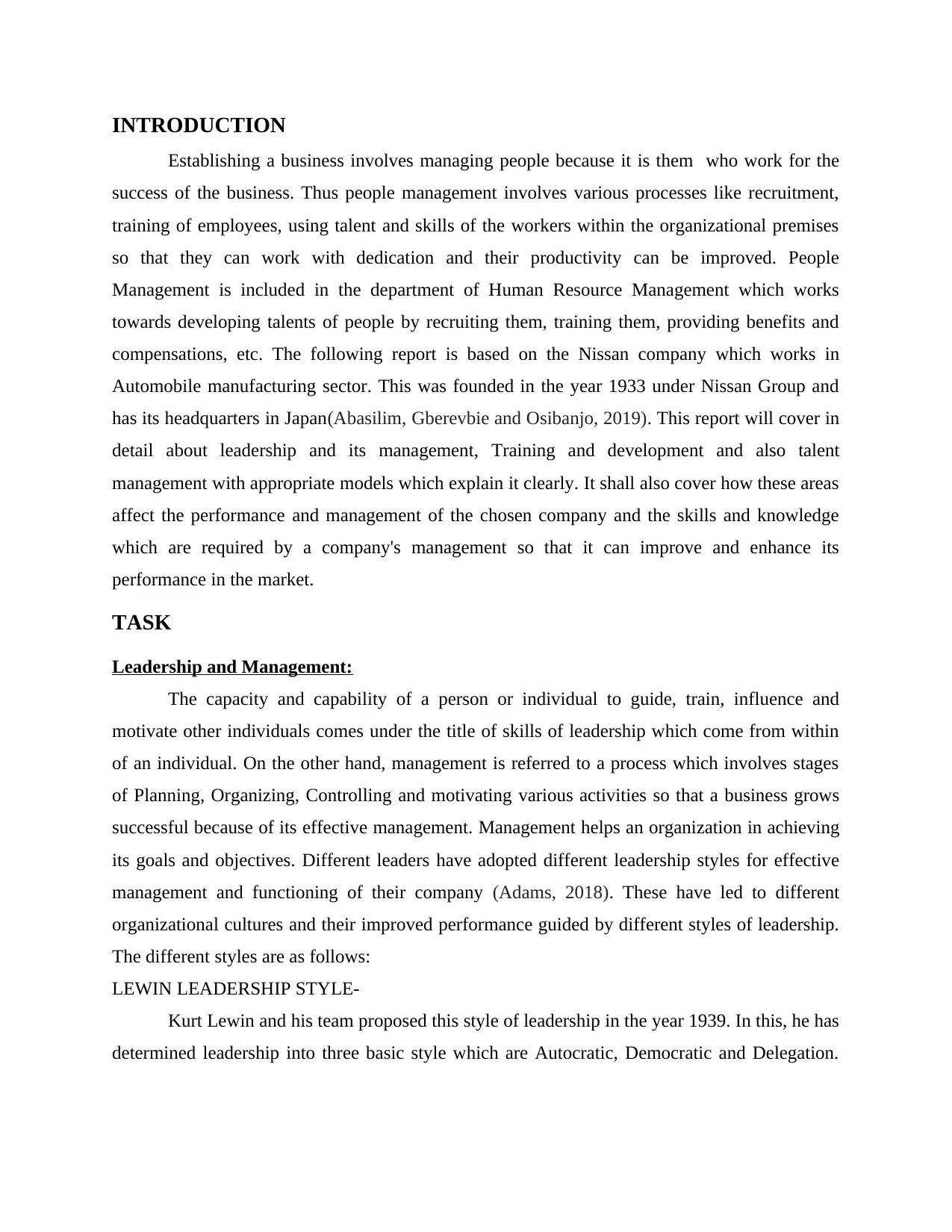
INTRODUCTION
Establishing a business involves managing people because it is them who work for the
success of the business. Thus people management involves various processes like recruitment,
training of employees, using talent and skills of the workers within the organizational premises
so that they can work with dedication and their productivity can be improved. People
Management is included in the department of Human Resource Management which works
towards developing talents of people by recruiting them, training them, providing benefits and
compensations, etc. The following report is based on the Nissan company which works in
Automobile manufacturing sector. This was founded in the year 1933 under Nissan Group and
has its headquarters in Japan(Abasilim, Gberevbie and Osibanjo, 2019). This report will cover in
detail about leadership and its management, Training and development and also talent
management with appropriate models which explain it clearly. It shall also cover how these areas
affect the performance and management of the chosen company and the skills and knowledge
which are required by a company's management so that it can improve and enhance its
performance in the market.
TASK
Leadership and Management:
The capacity and capability of a person or individual to guide, train, influence and
motivate other individuals comes under the title of skills of leadership which come from within
of an individual. On the other hand, management is referred to a process which involves stages
of Planning, Organizing, Controlling and motivating various activities so that a business grows
successful because of its effective management. Management helps an organization in achieving
its goals and objectives. Different leaders have adopted different leadership styles for effective
management and functioning of their company (Adams, 2018). These have led to different
organizational cultures and their improved performance guided by different styles of leadership.
The different styles are as follows:
LEWIN LEADERSHIP STYLE-
Kurt Lewin and his team proposed this style of leadership in the year 1939. In this, he has
determined leadership into three basic style which are Autocratic, Democratic and Delegation.
Establishing a business involves managing people because it is them who work for the
success of the business. Thus people management involves various processes like recruitment,
training of employees, using talent and skills of the workers within the organizational premises
so that they can work with dedication and their productivity can be improved. People
Management is included in the department of Human Resource Management which works
towards developing talents of people by recruiting them, training them, providing benefits and
compensations, etc. The following report is based on the Nissan company which works in
Automobile manufacturing sector. This was founded in the year 1933 under Nissan Group and
has its headquarters in Japan(Abasilim, Gberevbie and Osibanjo, 2019). This report will cover in
detail about leadership and its management, Training and development and also talent
management with appropriate models which explain it clearly. It shall also cover how these areas
affect the performance and management of the chosen company and the skills and knowledge
which are required by a company's management so that it can improve and enhance its
performance in the market.
TASK
Leadership and Management:
The capacity and capability of a person or individual to guide, train, influence and
motivate other individuals comes under the title of skills of leadership which come from within
of an individual. On the other hand, management is referred to a process which involves stages
of Planning, Organizing, Controlling and motivating various activities so that a business grows
successful because of its effective management. Management helps an organization in achieving
its goals and objectives. Different leaders have adopted different leadership styles for effective
management and functioning of their company (Adams, 2018). These have led to different
organizational cultures and their improved performance guided by different styles of leadership.
The different styles are as follows:
LEWIN LEADERSHIP STYLE-
Kurt Lewin and his team proposed this style of leadership in the year 1939. In this, he has
determined leadership into three basic style which are Autocratic, Democratic and Delegation.
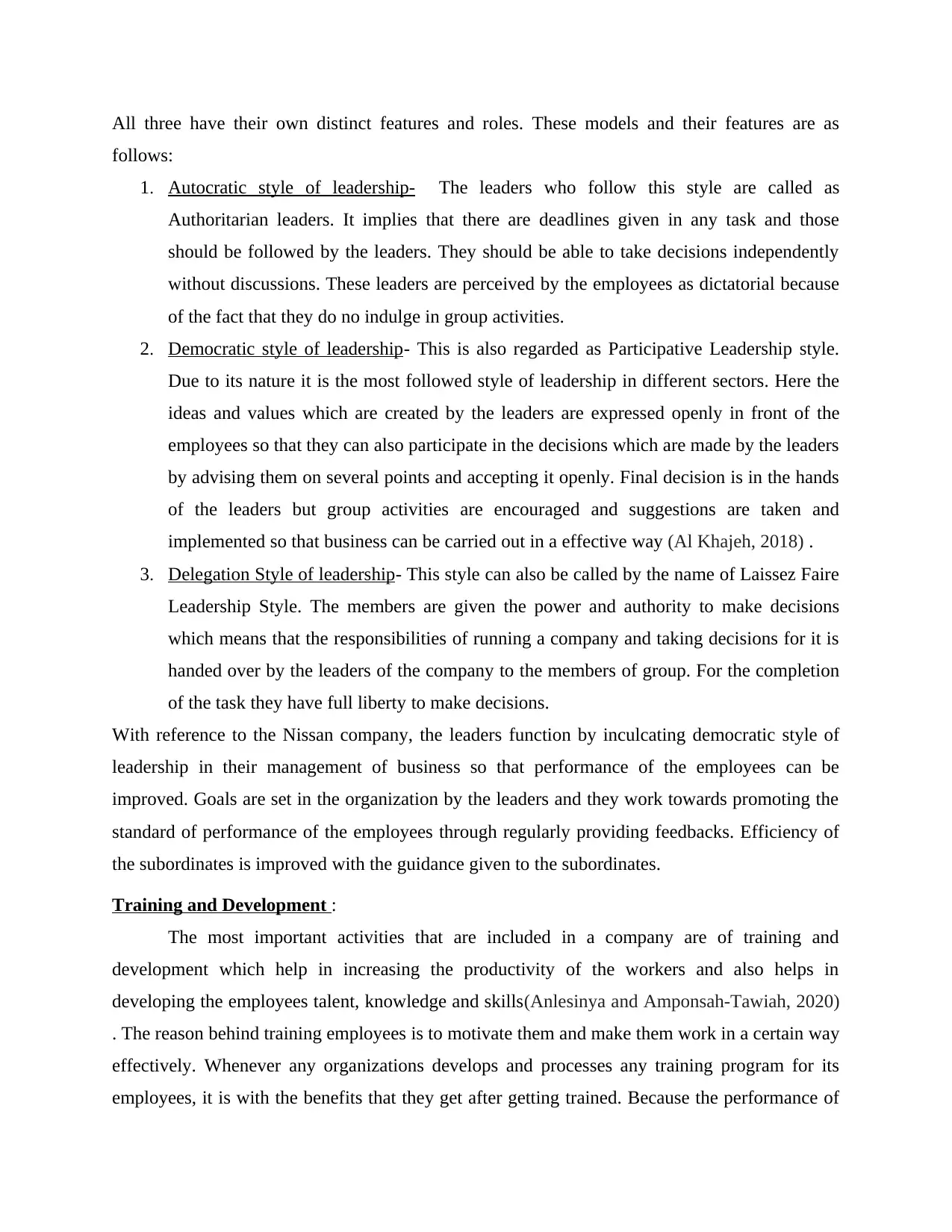
All three have their own distinct features and roles. These models and their features are as
follows:
1. Autocratic style of leadership- The leaders who follow this style are called as
Authoritarian leaders. It implies that there are deadlines given in any task and those
should be followed by the leaders. They should be able to take decisions independently
without discussions. These leaders are perceived by the employees as dictatorial because
of the fact that they do no indulge in group activities.
2. Democratic style of leadership- This is also regarded as Participative Leadership style.
Due to its nature it is the most followed style of leadership in different sectors. Here the
ideas and values which are created by the leaders are expressed openly in front of the
employees so that they can also participate in the decisions which are made by the leaders
by advising them on several points and accepting it openly. Final decision is in the hands
of the leaders but group activities are encouraged and suggestions are taken and
implemented so that business can be carried out in a effective way (Al Khajeh, 2018) .
3. Delegation Style of leadership- This style can also be called by the name of Laissez Faire
Leadership Style. The members are given the power and authority to make decisions
which means that the responsibilities of running a company and taking decisions for it is
handed over by the leaders of the company to the members of group. For the completion
of the task they have full liberty to make decisions.
With reference to the Nissan company, the leaders function by inculcating democratic style of
leadership in their management of business so that performance of the employees can be
improved. Goals are set in the organization by the leaders and they work towards promoting the
standard of performance of the employees through regularly providing feedbacks. Efficiency of
the subordinates is improved with the guidance given to the subordinates.
Training and Development :
The most important activities that are included in a company are of training and
development which help in increasing the productivity of the workers and also helps in
developing the employees talent, knowledge and skills(Anlesinya and Amponsah-Tawiah, 2020)
. The reason behind training employees is to motivate them and make them work in a certain way
effectively. Whenever any organizations develops and processes any training program for its
employees, it is with the benefits that they get after getting trained. Because the performance of
follows:
1. Autocratic style of leadership- The leaders who follow this style are called as
Authoritarian leaders. It implies that there are deadlines given in any task and those
should be followed by the leaders. They should be able to take decisions independently
without discussions. These leaders are perceived by the employees as dictatorial because
of the fact that they do no indulge in group activities.
2. Democratic style of leadership- This is also regarded as Participative Leadership style.
Due to its nature it is the most followed style of leadership in different sectors. Here the
ideas and values which are created by the leaders are expressed openly in front of the
employees so that they can also participate in the decisions which are made by the leaders
by advising them on several points and accepting it openly. Final decision is in the hands
of the leaders but group activities are encouraged and suggestions are taken and
implemented so that business can be carried out in a effective way (Al Khajeh, 2018) .
3. Delegation Style of leadership- This style can also be called by the name of Laissez Faire
Leadership Style. The members are given the power and authority to make decisions
which means that the responsibilities of running a company and taking decisions for it is
handed over by the leaders of the company to the members of group. For the completion
of the task they have full liberty to make decisions.
With reference to the Nissan company, the leaders function by inculcating democratic style of
leadership in their management of business so that performance of the employees can be
improved. Goals are set in the organization by the leaders and they work towards promoting the
standard of performance of the employees through regularly providing feedbacks. Efficiency of
the subordinates is improved with the guidance given to the subordinates.
Training and Development :
The most important activities that are included in a company are of training and
development which help in increasing the productivity of the workers and also helps in
developing the employees talent, knowledge and skills(Anlesinya and Amponsah-Tawiah, 2020)
. The reason behind training employees is to motivate them and make them work in a certain way
effectively. Whenever any organizations develops and processes any training program for its
employees, it is with the benefits that they get after getting trained. Because the performance of
Secure Best Marks with AI Grader
Need help grading? Try our AI Grader for instant feedback on your assignments.
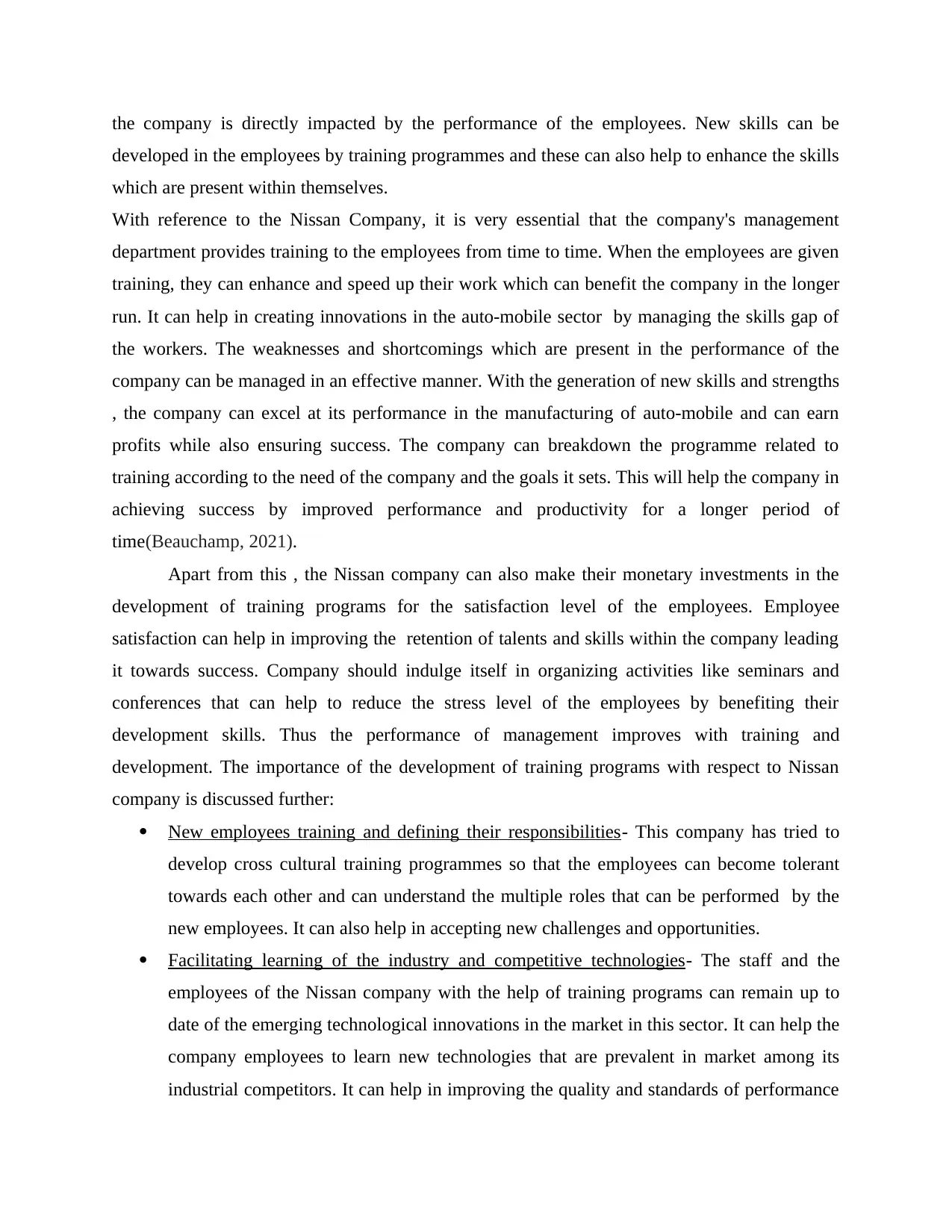
the company is directly impacted by the performance of the employees. New skills can be
developed in the employees by training programmes and these can also help to enhance the skills
which are present within themselves.
With reference to the Nissan Company, it is very essential that the company's management
department provides training to the employees from time to time. When the employees are given
training, they can enhance and speed up their work which can benefit the company in the longer
run. It can help in creating innovations in the auto-mobile sector by managing the skills gap of
the workers. The weaknesses and shortcomings which are present in the performance of the
company can be managed in an effective manner. With the generation of new skills and strengths
, the company can excel at its performance in the manufacturing of auto-mobile and can earn
profits while also ensuring success. The company can breakdown the programme related to
training according to the need of the company and the goals it sets. This will help the company in
achieving success by improved performance and productivity for a longer period of
time(Beauchamp, 2021).
Apart from this , the Nissan company can also make their monetary investments in the
development of training programs for the satisfaction level of the employees. Employee
satisfaction can help in improving the retention of talents and skills within the company leading
it towards success. Company should indulge itself in organizing activities like seminars and
conferences that can help to reduce the stress level of the employees by benefiting their
development skills. Thus the performance of management improves with training and
development. The importance of the development of training programs with respect to Nissan
company is discussed further:
New employees training and defining their responsibilities- This company has tried to
develop cross cultural training programmes so that the employees can become tolerant
towards each other and can understand the multiple roles that can be performed by the
new employees. It can also help in accepting new challenges and opportunities.
Facilitating learning of the industry and competitive technologies- The staff and the
employees of the Nissan company with the help of training programs can remain up to
date of the emerging technological innovations in the market in this sector. It can help the
company employees to learn new technologies that are prevalent in market among its
industrial competitors. It can help in improving the quality and standards of performance
developed in the employees by training programmes and these can also help to enhance the skills
which are present within themselves.
With reference to the Nissan Company, it is very essential that the company's management
department provides training to the employees from time to time. When the employees are given
training, they can enhance and speed up their work which can benefit the company in the longer
run. It can help in creating innovations in the auto-mobile sector by managing the skills gap of
the workers. The weaknesses and shortcomings which are present in the performance of the
company can be managed in an effective manner. With the generation of new skills and strengths
, the company can excel at its performance in the manufacturing of auto-mobile and can earn
profits while also ensuring success. The company can breakdown the programme related to
training according to the need of the company and the goals it sets. This will help the company in
achieving success by improved performance and productivity for a longer period of
time(Beauchamp, 2021).
Apart from this , the Nissan company can also make their monetary investments in the
development of training programs for the satisfaction level of the employees. Employee
satisfaction can help in improving the retention of talents and skills within the company leading
it towards success. Company should indulge itself in organizing activities like seminars and
conferences that can help to reduce the stress level of the employees by benefiting their
development skills. Thus the performance of management improves with training and
development. The importance of the development of training programs with respect to Nissan
company is discussed further:
New employees training and defining their responsibilities- This company has tried to
develop cross cultural training programmes so that the employees can become tolerant
towards each other and can understand the multiple roles that can be performed by the
new employees. It can also help in accepting new challenges and opportunities.
Facilitating learning of the industry and competitive technologies- The staff and the
employees of the Nissan company with the help of training programs can remain up to
date of the emerging technological innovations in the market in this sector. It can help the
company employees to learn new technologies that are prevalent in market among its
industrial competitors. It can help in improving the quality and standards of performance

of the employees that can lead to better performance of the company because innovative
technologies always prosper in the market (Delanoy and Kasztelnik, 2020).
Developing soft skills- The employees and their soft skills can be improved by the
development of special training programmes aimed at soft skills. It can help the
employees in adopting changes that can help them in the organization. These soft skills
can be emotional intelligence and resilience which can help in the creation of a healthy
atmosphere which improves trust and bonding in the Nissan company's heads and
employees.
Talent Management:
It is referred to the anticipation that is made regarding the no. of employees that are
essential and required for any organization to develop strategies and plans so that the goals and
objectives of the company can be achieved (Demir and Budur, 2019). Thus all those activities
which relate to human resource management are included under the talent management. Thus it
includes hiring new employees according to the vacancy and need of the post in the organization
and managing their skills. These are the primary responsibilities which a talent manager has to
look after in the company. Employees being the biggest asset of the company managing their
skills and talent is very essential and required. The top talents of the company should be retained
by it so that the company can develop effectively. With reference to the Nissan company, proper
strategies are required to be made by the company so that it can improve its employees talents.
This talent management process has been discussed below in context of the Nissan Company:
Planning- This is the most basic and initial stage of this process of talent management. In
relation to the Nissan company, the management of the company should identify how
much human capital is required by the company and also define its job roles and
responsibilities so that workforce can be managed (Löfsten, Klofsten and Cadorin,
2020).
Attracting- The Nissan company should make decisions about how the internal source or
external source of the recruitment can be used to fill the vacancy in the company. It
should develop plans that can attract new recruits into the company. It can be done with
the help of different job sites like indeed or with social media like LinkedIn.
technologies always prosper in the market (Delanoy and Kasztelnik, 2020).
Developing soft skills- The employees and their soft skills can be improved by the
development of special training programmes aimed at soft skills. It can help the
employees in adopting changes that can help them in the organization. These soft skills
can be emotional intelligence and resilience which can help in the creation of a healthy
atmosphere which improves trust and bonding in the Nissan company's heads and
employees.
Talent Management:
It is referred to the anticipation that is made regarding the no. of employees that are
essential and required for any organization to develop strategies and plans so that the goals and
objectives of the company can be achieved (Demir and Budur, 2019). Thus all those activities
which relate to human resource management are included under the talent management. Thus it
includes hiring new employees according to the vacancy and need of the post in the organization
and managing their skills. These are the primary responsibilities which a talent manager has to
look after in the company. Employees being the biggest asset of the company managing their
skills and talent is very essential and required. The top talents of the company should be retained
by it so that the company can develop effectively. With reference to the Nissan company, proper
strategies are required to be made by the company so that it can improve its employees talents.
This talent management process has been discussed below in context of the Nissan Company:
Planning- This is the most basic and initial stage of this process of talent management. In
relation to the Nissan company, the management of the company should identify how
much human capital is required by the company and also define its job roles and
responsibilities so that workforce can be managed (Löfsten, Klofsten and Cadorin,
2020).
Attracting- The Nissan company should make decisions about how the internal source or
external source of the recruitment can be used to fill the vacancy in the company. It
should develop plans that can attract new recruits into the company. It can be done with
the help of different job sites like indeed or with social media like LinkedIn.

Selecting- Nissan for the purpose of recruitment and selection process of its employees
should conduct tests which can help in analysing the talent and skills of the new
employees.
Developing- further, after the selection process of employees they needs to be trained as
per the profile of the company. The said company which is Nissan proceeds with the
process of orientation which helps the employees in developing their skills and also aids
in improving their aptitude levels.
Retaining- the survival and growth of every company in the competition, depends on the
rate of retention of its employees. Similarly, Nissan in order to alter the retention rate of
its employees ensures several increments and promotions of their employees and also in
some situations asks for the involvement in the process of decision making.
Transitioning- the primary task of talent management is to modify its workers in such a
way which leads in effective achieving the goals of the company. The Nissan company
fulfils the same by aiding retirement benefits to their workers and also while providing
some internal promotions to them(Whysall, Owtram and Brittain, 2019).
Recommendations-
Knowledge, skills and Behaviour required by management to serve the three key areas-
leadership and management: in order to carry out the tasks in with an effective manner of
the company, it is very much required to have a keen understanding about the prevailing
styles of leadership, skills required in taking decision and aiding of employees in
completing their tasks.
Training and development: for the reason to enhance the productivity of their employees
the company should also have a knowledge of training programs and also the advanced
planning and strategic thinking.
Talent management: the knowledge about the process of management and the honesty
and trustworthiness of the management for the company is also very much required on
the part of company.
should conduct tests which can help in analysing the talent and skills of the new
employees.
Developing- further, after the selection process of employees they needs to be trained as
per the profile of the company. The said company which is Nissan proceeds with the
process of orientation which helps the employees in developing their skills and also aids
in improving their aptitude levels.
Retaining- the survival and growth of every company in the competition, depends on the
rate of retention of its employees. Similarly, Nissan in order to alter the retention rate of
its employees ensures several increments and promotions of their employees and also in
some situations asks for the involvement in the process of decision making.
Transitioning- the primary task of talent management is to modify its workers in such a
way which leads in effective achieving the goals of the company. The Nissan company
fulfils the same by aiding retirement benefits to their workers and also while providing
some internal promotions to them(Whysall, Owtram and Brittain, 2019).
Recommendations-
Knowledge, skills and Behaviour required by management to serve the three key areas-
leadership and management: in order to carry out the tasks in with an effective manner of
the company, it is very much required to have a keen understanding about the prevailing
styles of leadership, skills required in taking decision and aiding of employees in
completing their tasks.
Training and development: for the reason to enhance the productivity of their employees
the company should also have a knowledge of training programs and also the advanced
planning and strategic thinking.
Talent management: the knowledge about the process of management and the honesty
and trustworthiness of the management for the company is also very much required on
the part of company.
Paraphrase This Document
Need a fresh take? Get an instant paraphrase of this document with our AI Paraphraser
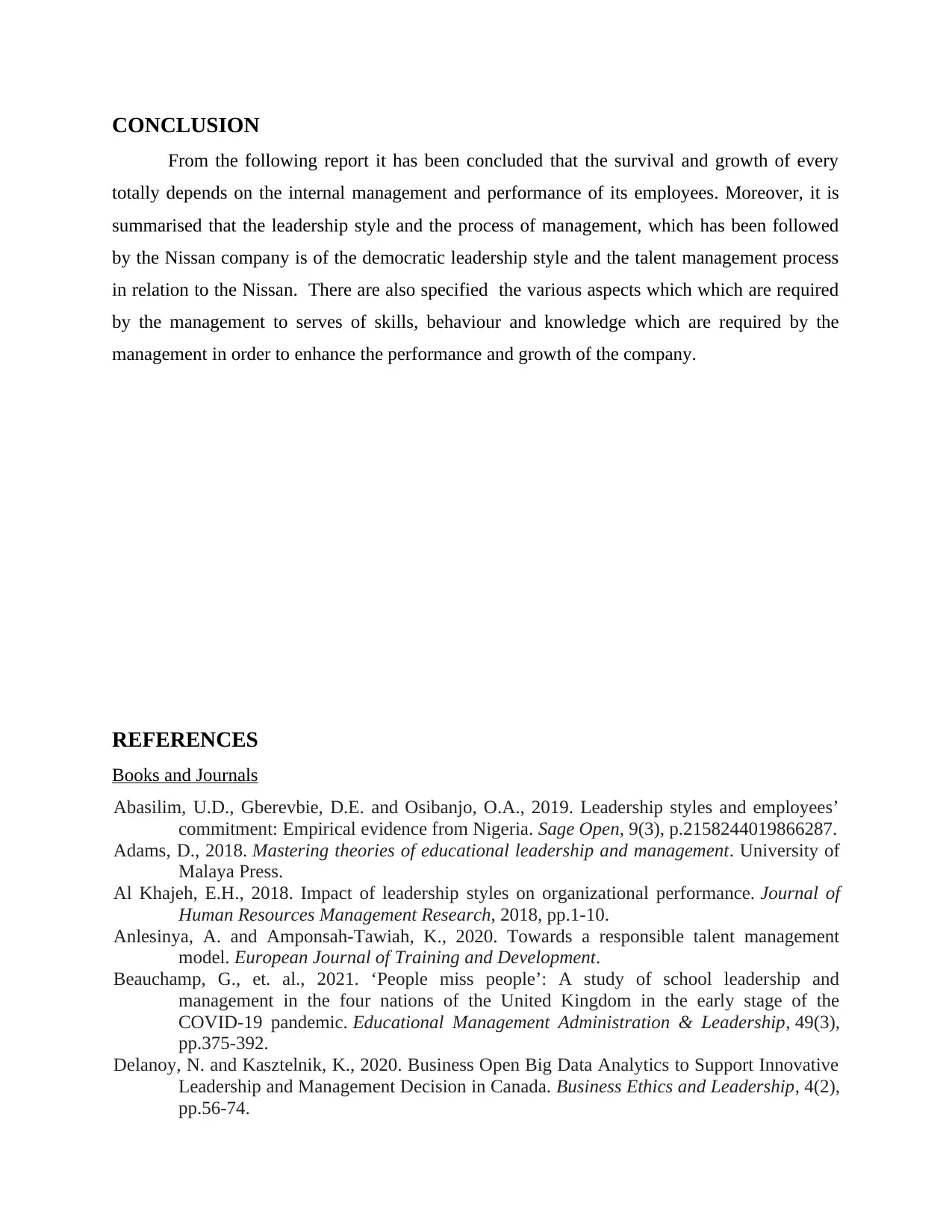
CONCLUSION
From the following report it has been concluded that the survival and growth of every
totally depends on the internal management and performance of its employees. Moreover, it is
summarised that the leadership style and the process of management, which has been followed
by the Nissan company is of the democratic leadership style and the talent management process
in relation to the Nissan. There are also specified the various aspects which which are required
by the management to serves of skills, behaviour and knowledge which are required by the
management in order to enhance the performance and growth of the company.
REFERENCES
Books and Journals
Abasilim, U.D., Gberevbie, D.E. and Osibanjo, O.A., 2019. Leadership styles and employees’
commitment: Empirical evidence from Nigeria. Sage Open, 9(3), p.2158244019866287.
Adams, D., 2018. Mastering theories of educational leadership and management. University of
Malaya Press.
Al Khajeh, E.H., 2018. Impact of leadership styles on organizational performance. Journal of
Human Resources Management Research, 2018, pp.1-10.
Anlesinya, A. and Amponsah-Tawiah, K., 2020. Towards a responsible talent management
model. European Journal of Training and Development.
Beauchamp, G., et. al., 2021. ‘People miss people’: A study of school leadership and
management in the four nations of the United Kingdom in the early stage of the
COVID-19 pandemic. Educational Management Administration & Leadership, 49(3),
pp.375-392.
Delanoy, N. and Kasztelnik, K., 2020. Business Open Big Data Analytics to Support Innovative
Leadership and Management Decision in Canada. Business Ethics and Leadership, 4(2),
pp.56-74.
From the following report it has been concluded that the survival and growth of every
totally depends on the internal management and performance of its employees. Moreover, it is
summarised that the leadership style and the process of management, which has been followed
by the Nissan company is of the democratic leadership style and the talent management process
in relation to the Nissan. There are also specified the various aspects which which are required
by the management to serves of skills, behaviour and knowledge which are required by the
management in order to enhance the performance and growth of the company.
REFERENCES
Books and Journals
Abasilim, U.D., Gberevbie, D.E. and Osibanjo, O.A., 2019. Leadership styles and employees’
commitment: Empirical evidence from Nigeria. Sage Open, 9(3), p.2158244019866287.
Adams, D., 2018. Mastering theories of educational leadership and management. University of
Malaya Press.
Al Khajeh, E.H., 2018. Impact of leadership styles on organizational performance. Journal of
Human Resources Management Research, 2018, pp.1-10.
Anlesinya, A. and Amponsah-Tawiah, K., 2020. Towards a responsible talent management
model. European Journal of Training and Development.
Beauchamp, G., et. al., 2021. ‘People miss people’: A study of school leadership and
management in the four nations of the United Kingdom in the early stage of the
COVID-19 pandemic. Educational Management Administration & Leadership, 49(3),
pp.375-392.
Delanoy, N. and Kasztelnik, K., 2020. Business Open Big Data Analytics to Support Innovative
Leadership and Management Decision in Canada. Business Ethics and Leadership, 4(2),
pp.56-74.
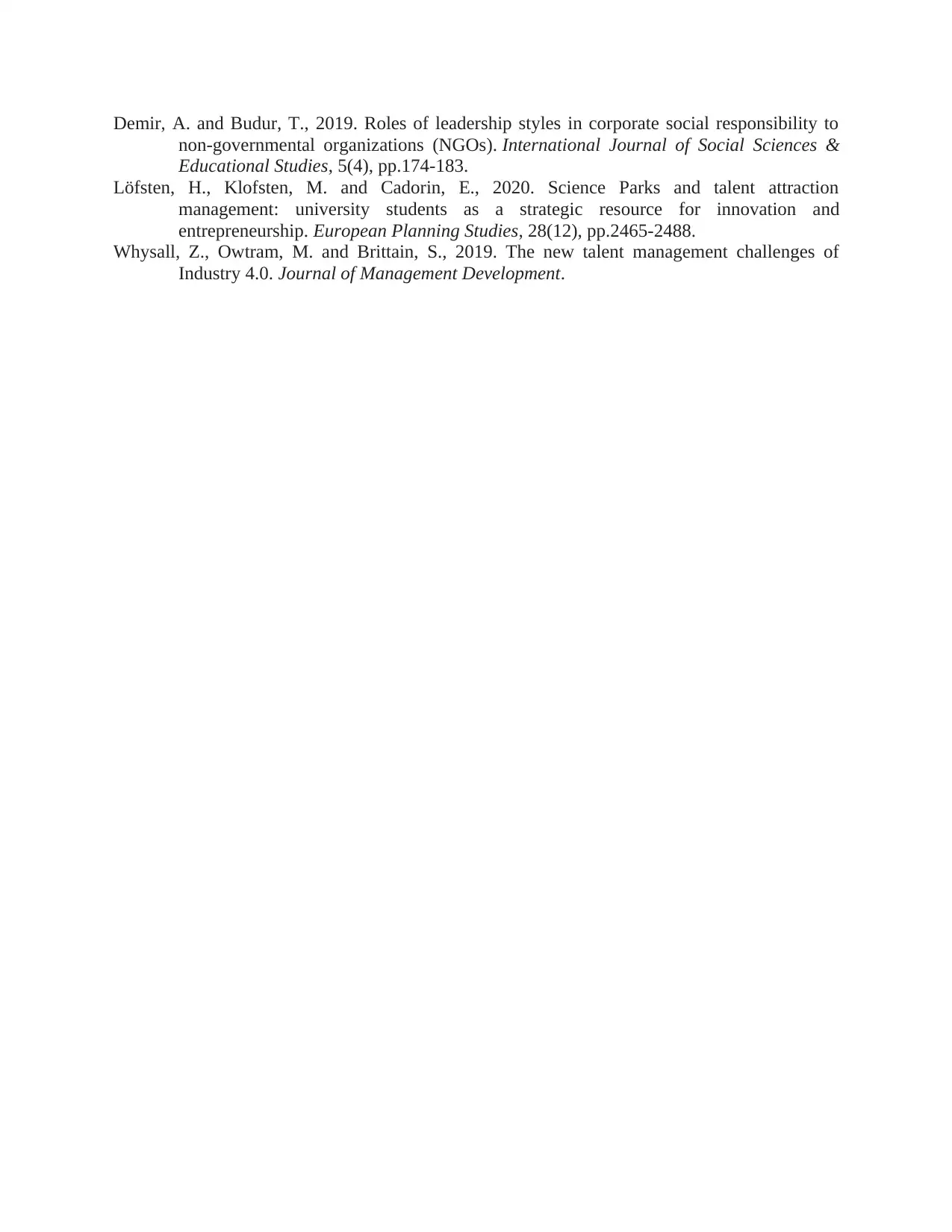
Demir, A. and Budur, T., 2019. Roles of leadership styles in corporate social responsibility to
non-governmental organizations (NGOs). International Journal of Social Sciences &
Educational Studies, 5(4), pp.174-183.
Löfsten, H., Klofsten, M. and Cadorin, E., 2020. Science Parks and talent attraction
management: university students as a strategic resource for innovation and
entrepreneurship. European Planning Studies, 28(12), pp.2465-2488.
Whysall, Z., Owtram, M. and Brittain, S., 2019. The new talent management challenges of
Industry 4.0. Journal of Management Development.
non-governmental organizations (NGOs). International Journal of Social Sciences &
Educational Studies, 5(4), pp.174-183.
Löfsten, H., Klofsten, M. and Cadorin, E., 2020. Science Parks and talent attraction
management: university students as a strategic resource for innovation and
entrepreneurship. European Planning Studies, 28(12), pp.2465-2488.
Whysall, Z., Owtram, M. and Brittain, S., 2019. The new talent management challenges of
Industry 4.0. Journal of Management Development.
1 out of 9
Related Documents
Your All-in-One AI-Powered Toolkit for Academic Success.
+13062052269
info@desklib.com
Available 24*7 on WhatsApp / Email
![[object Object]](/_next/static/media/star-bottom.7253800d.svg)
Unlock your academic potential
© 2024 | Zucol Services PVT LTD | All rights reserved.




